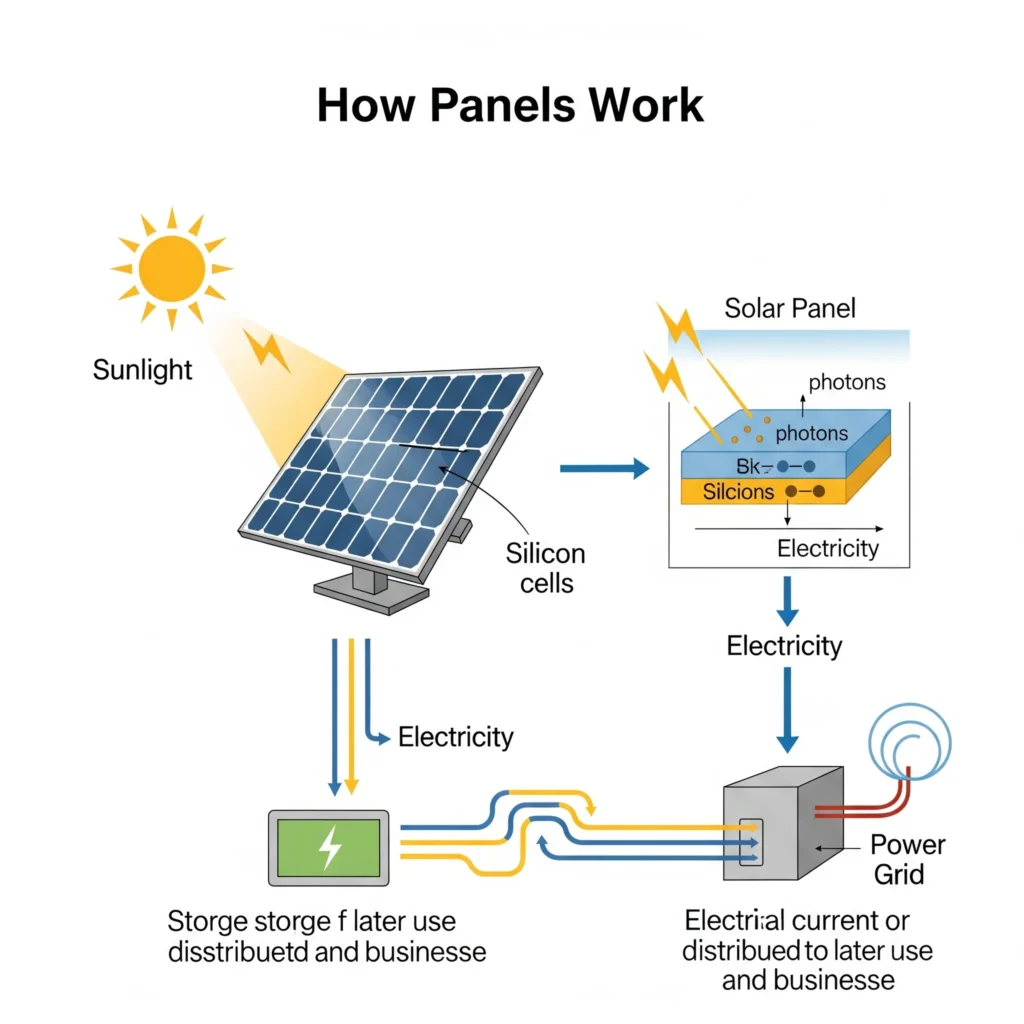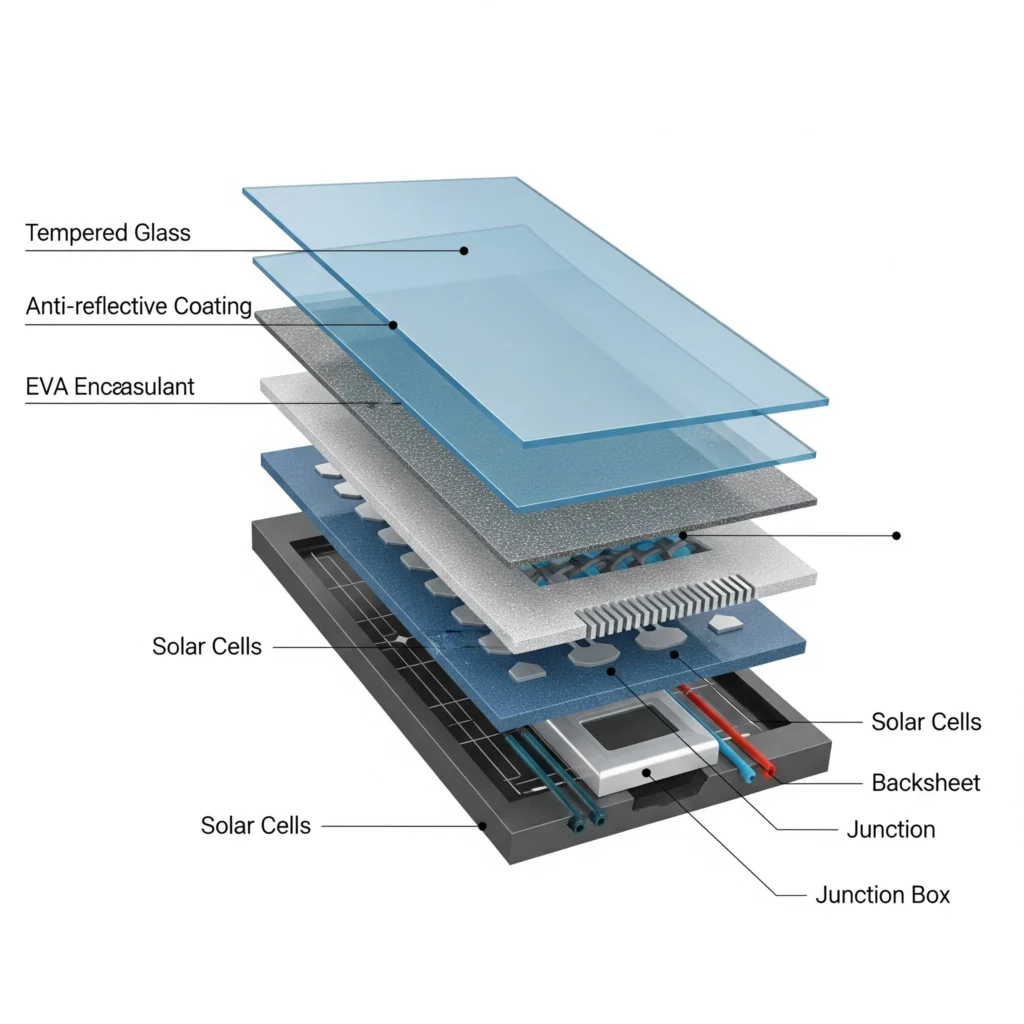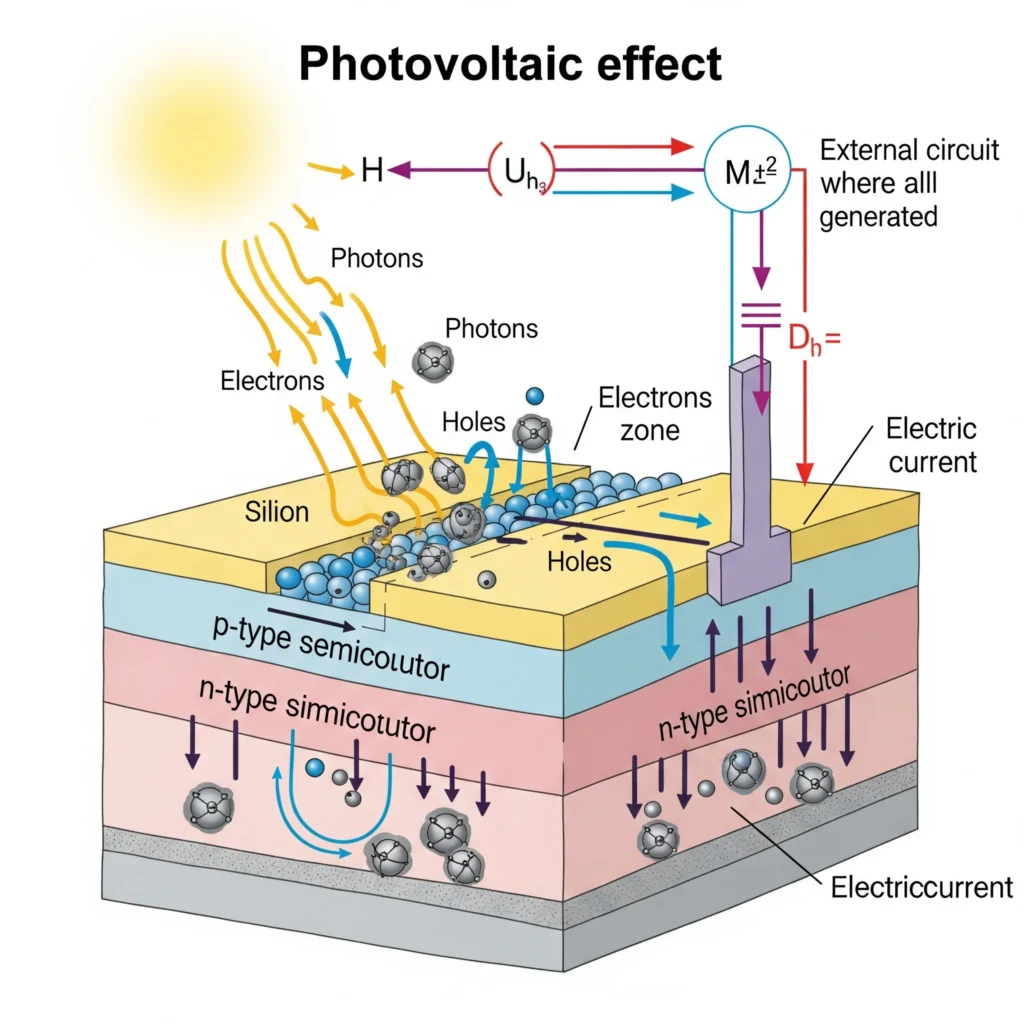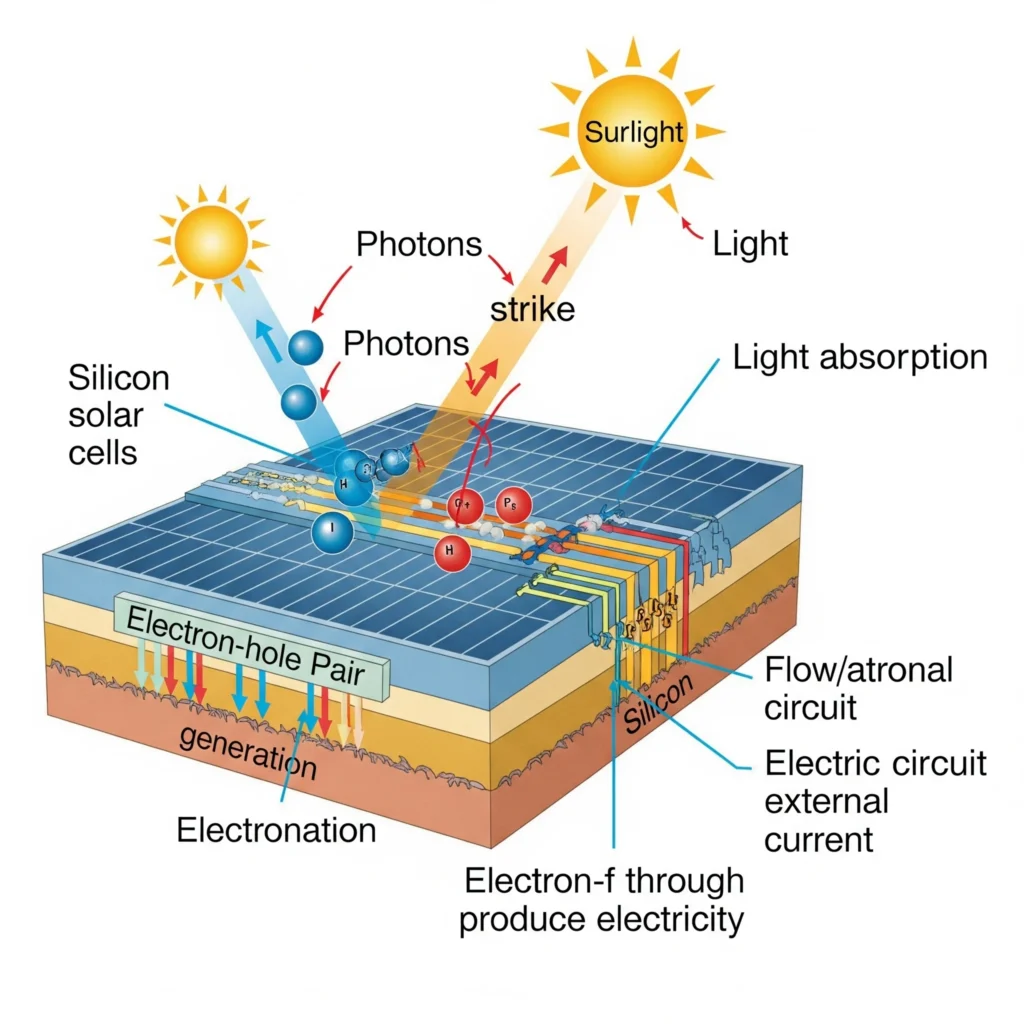Have you ever gazed up at the sun and wondered how its powerful rays can be harnessed to light up your home? Solar panels have become an increasingly popular solution to energy needs, yet many people are still unsure how they work.
You’re not alone! By understanding the basic mechanics behind solar panels, you can unlock the potential of this renewable energy source. Imagine reducing your energy bills while helping the environment—sounds great, right? You’ll get a clear and straightforward explanation of how solar panels work, complete with simple diagrams that make it easy to visualize the process.
So, if you’ve ever been curious about solar energy, keep reading to discover how you can harness the sun’s power for your own benefit.
Basics Of Solar Energy
Solar panels convert sunlight into electricity using photovoltaic cells. These cells contain silicon that absorbs sunlight, generating electric currents. Simple diagrams help visualize this process, showing how panels connect to your home’s electrical system. Understanding this can make solar energy easier to grasp.
Understanding the basics of solar energy can seem daunting, but it’s simpler than you might think. Solar panels harness energy from the sun, which is a renewable and abundant resource. This energy can be converted into electricity to power your home, reducing your reliance on traditional energy sources.
What Is Solar Energy?
Solar energy is the light and heat that come from the sun. It’s a powerful source of energy that has been used for thousands of years in various ways. Today, it’s captured using solar panels and converted into electricity or heat for practical use.
How Does Solar Energy Work?

Solar panels are made up of many solar cells. These cells are composed of semiconductor materials, usually silicon. When sunlight hits these cells, it causes electrons to move, creating an electric current.
The Role Of Photovoltaic Cells
Photovoltaic cells are the heart of solar panels. They convert sunlight directly into electricity. When the sunlight hits the cell, it knocks electrons loose. These free electrons flow through the material to produce electricity.
Why Is Solar Energy Important?
Solar energy is crucial for reducing our carbon footprint. By using solar panels, you can decrease your reliance on fossil fuels. This not only helps the environment but can also save you money on your energy bills.
How Can You Use Solar Energy?
You can use solar energy in many ways. Install solar panels on your roof to power your home. Use solar-powered devices, like chargers and lights, to reduce energy consumption.
Are you considering making the switch to solar energy? It’s an investment that pays off both financially and environmentally. Imagine the satisfaction of knowing your home is powered by the sun.
Components Of A Solar Panel

Understanding the components of a solar panel is like peeking under the hood of a car. Each part plays a crucial role in capturing sunlight and turning it into electricity for your home. Let’s dive into the essential components that make this magic happen.
Solar Cells
Solar cells are the heart of a solar panel. They are responsible for converting sunlight into electrical energy. Each cell is made of silicon, which is a semiconductor material that absorbs sunlight and releases electrons.
These electrons then flow, creating an electric current. The efficiency of a solar panel largely depends on the quality and type of solar cells used. Have you ever wondered how a small piece of silicon can power your entire home? It’s all about the collective work of these tiny cells!
Glass Cover
The glass cover protects the solar cells from environmental damage. It’s designed to be durable and weather-resistant, keeping the cells safe from rain, snow, and hail. But it’s not just about protection.
This glass also plays a crucial role in maximizing the amount of sunlight that reaches the cells. The glass is usually anti-reflective to ensure more light passes through rather than bouncing off.
Frame
The frame is the backbone of a solar panel. It holds everything together and provides structural support. Typically made from aluminum, the frame is lightweight yet sturdy.
It allows the panel to be easily mounted on rooftops or other structures. Imagine trying to install a panel without a frame—it would be like hanging a painting without a canvas!
Backsheet
The backsheet is the layer at the back of the solar panel. It provides insulation and protection against environmental factors. This layer ensures that no moisture or dirt reaches the delicate solar cells.
The backsheet also helps with heat dissipation, keeping the panel cool. Ever touched a panel on a sunny day? They can get pretty hot, and that’s where the backsheet proves its worth.
Junction Box
The junction box is where all the electrical connections are made. It’s like the nerve center of a solar panel. This box houses the wiring and provides a secure outlet for electricity to flow to your home.
It also contains bypass diodes, which help maintain panel efficiency if one part is shaded. Have you ever noticed how some panels keep working even with a shadow? Thank the junction box for that!
Each component of a solar panel has a specific role, contributing to its overall efficiency and durability. Next time you see a solar panel, you’ll know exactly what’s making it tick. Consider how each part works together to power your everyday life. Isn’t it fascinating how technology harnesses nature so effectively?
Photovoltaic Effect

Solar panels convert sunlight into electricity using the photovoltaic effect. Sunlight hits the solar cells, creating an electric current. Simple diagrams help illustrate how this process generates power for homes and businesses.
Understanding the magic behind solar panels starts with the “Photovoltaic Effect.” This is the process that allows solar panels to convert sunlight into electricity. It’s a fascinating concept that turns something as simple as sunlight into a powerful energy source.
What Is The Photovoltaic Effect?
The photovoltaic effect occurs when sunlight hits the solar cells on a panel. These cells are made from semiconductor materials, like silicon. When sunlight strikes these cells, it knocks electrons loose, creating an electric current.
How Do Solar Cells Generate Electricity?
Solar cells have a positive and a negative layer. When the sunlight excites the electrons, it sets them into motion between these layers. This movement generates a flow of electricity that can be harnessed for power.
The Role Of Semiconductors
Semiconductors are crucial in solar panels. They allow electrons to move freely, which is essential for generating electricity. Silicon is the most commonly used semiconductor because it’s effective and abundant.
Why Do Solar Panels Have Multiple Cells?
A single solar cell doesn’t produce much electricity. To generate enough power, solar panels combine multiple cells. This increases the amount of electricity that can be produced from the same amount of sunlight.
Can You Rely On Solar Panels Year-round?
Solar panels work best in direct sunlight, but they can still generate electricity on cloudy days. They even work during winter months, though efficiency may decrease. Have you ever thought about how much sunlight your roof gets throughout the year?
Real-life Example: My First Solar Panel Installation
When I installed solar panels on my roof, I was amazed at how quickly they started generating power. Watching the energy meter spin backward was a thrill. It made me realize the potential of harnessing solar energy effectively.
How Can You Maximize Solar Panel Efficiency?
Position your panels to capture the most sunlight. Regular maintenance, like cleaning, can also help. Ensuring no obstructions like trees or buildings block the sunlight is key.
Understanding the photovoltaic effect not only helps you appreciate the technology behind solar panels but also empowers you to make informed decisions about using solar energy in your life. Have you considered how solar energy could transform your home’s power supply?
Conversion Of Sunlight To Electricity

Solar panels turn sunlight into electricity through a fascinating process. This transformation involves several steps, making it easy to grasp with simple diagrams. Understanding this process helps appreciate the technology behind solar energy. Let’s break it down into easy-to-follow sections.
How Photovoltaic Cells Capture Sunlight
Photovoltaic cells are the heart of solar panels. They are made of semiconductor materials like silicon. When sunlight hits these cells, it excites electrons. This excitement causes electrons to move, creating an electric current. This initial step is crucial for electricity generation.
The Role Of Silicon In Solar Panels
Silicon plays a vital role in solar panels. It forms a crystal lattice, which provides a structured path for electrons. When sunlight strikes the silicon, it frees electrons from the structure. These free electrons then flow, generating electricity. This flow is the basis of the energy we use.
Understanding The Electric Field In Solar Cells
An electric field within solar cells guides electron flow. The field is created by layering silicon with different charges. This arrangement forms a junction, separating charges. As electrons are freed, the electric field directs them to create a current. This controlled flow is what powers devices.
The Conversion Of Direct Current To Usable Electricity
Once generated, the electricity is in direct current (DC) form. Most appliances use alternating current (AC), so conversion is needed. Inverters convert DC into AC electricity. This step ensures compatibility with household devices. With this conversion, solar energy becomes usable.
Types Of Solar Panels
Solar panels convert sunlight into electricity using photovoltaic cells. There are three main types: monocrystalline, polycrystalline, and thin-film. Each type has unique features and efficiency levels, explained clearly with diagrams in our guide.
Understanding the different types of solar panels is crucial when deciding which one suits your needs best. With the technology rapidly evolving, it’s easy to feel overwhelmed by choices. But don’t worry; this guide will help you make sense of it all, starting with the three main types of solar panels commonly used today.
Monocrystalline Solar Panels
Monocrystalline panels are known for their high efficiency and sleek design. Made from a single, pure crystal structure, they maximize electricity production even in limited space. These panels are often more expensive, but they offer longevity and superior performance, making them a great choice if you’re looking to make a long-term investment.
Polycrystalline Solar Panels
Polycrystalline panels are made from multiple silicon crystals melted together. This process is less costly, which makes these panels more affordable. However, they tend to be slightly less efficient than their monocrystalline counterparts. If you’re on a budget and have ample roof space, polycrystalline panels can be a practical option.
Thin-film Solar Panels
Thin-film panels are lightweight and flexible, allowing for versatile installations. They’re made by applying one or more layers of photovoltaic material onto a substrate. These panels are less efficient compared to crystalline panels but can be a good fit for large-scale installations where weight and flexibility are crucial factors. Imagine a solar-powered RV or a commercial building with a unique roof shape—thin-film panels could be the answer.
Choosing the right type of solar panel often boils down to your specific needs and constraints. Are you limited on roof space but want high efficiency? Monocrystalline might be your best bet. Do you have a large roof and a smaller budget? Consider polycrystalline. Need flexibility for a unique installation? Thin-film might suit you perfectly.
Take a moment to assess what you value most in a solar panel. Efficiency, cost, or flexibility? Understanding your priorities will help you make an informed decision. And remember, the best solar panel for you is the one that meets your unique needs and lifestyle.
Conclusion
Solar panels capture sunlight and convert it into electricity. Simple yet effective. Understanding this process can help us appreciate clean energy. The sun’s power is harnessed through photovoltaic cells. These cells are the heart of solar panels. They transform light into electrical energy.
This energy powers our homes, reducing reliance on fossil fuels. Solar technology is evolving. Making it more accessible and efficient. Embrace solar power to contribute to a sustainable future. It’s a step towards cleaner energy. A choice for our planet’s health.
Explore this renewable energy source today. Let sunlight power your world.
